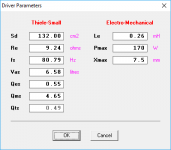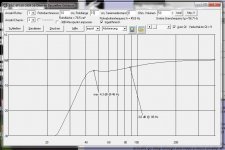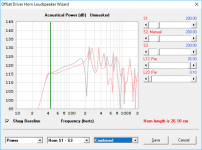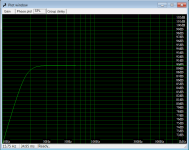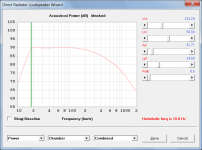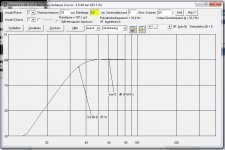Your simulation looks very close. The differences could even be just measurement tolerances. Well, if I simulate the 'close' B&C 6PS38, however, I come to this:
If you simulate a different driver in a different alignment, you'll get different results.
The t/s parameters of the driver Chris is using work out as per the attachment. Can your program sim in in the slot-loaded box that Chris is considering?
I do agree on the use of a larger driver, but I'd try to match efficiency. Those car audio drivers have the Xmax to hit higher SPLs, but there's a significant difference in efficiency.
Attachments
A down firing 12 or two 10's would perform far better.
Absolutely! Even a single 10" would perform better, it's roughly the same cone surface as 3 6" drivers.
115db maximum is rather low for anything but background music in my opinion and experience. You always want MORE bass than top end for live music playback, so 115db maximum output at LF would mean 105 or so for mid/hf at 1m. That's barely 95-96db PEAK at 10m for bass, 85 for midband. Nowhere near enough for anything but a solo guitar in a quiet restaurant.
10m from the speakers with background noise(people talking/yelling etc) would almost drown this out.
115db midband and 125db bass down to 40hz would be the MINIMUM for anything with 50-100 guests.
That are realistic numbers, I can confirm that. And you want to avoid driving everything on the limit anyway, the subs won't live very long otherwise.
Bose tried a similar idea with the MB4 'sub' which has widely been shunned by the PA community as you need 4 or more to replace a 'real' PA sub.
Yes, they got ridiculed by everyone. It was so bad, not even the chinese noname copied it! No wonder people got creative with the explanation for BOSE:
Bass Output Seriously Exiguous
Beats Only Saddest Electronics
Bought On Salesdoofus Encouragement
😀
The t/s parameters of the driver Chris is using work out as per the attachment. Can your program sim in in the slot-loaded box that Chris is considering?
It looks better but it's by no means usable for high spl. Still the bump at the lower end.
The slot does not much at the lower end, the upper end (>200 Hz) will probably look different, I wouldn't rely on the simulation there though, the surroundings, PAX etc will change there a lot.
I do agree on the use of a larger driver, but I'd try to match efficiency. Those car audio drivers have the Xmax to hit higher SPLs, but there's a significant difference in efficiency.
Yes, ofcourse. I mentioned that because even with car audio you'd get much better results or comparable (and still better sounding) but a lot smaller - because that was one of the essential design goals.
Attachments
The Bose MB4 is rated 110dB 40Hz~200Hz.
Yes, that's pretty low.
It's pretty much the same like this sub here, they say 110 dB SPL (116 dB SPL peak). Well, still 1dB more.
It looks better but it's by no means usable for high spl. Still the bump at the lower end.
The slot does not much at the lower end, the upper end (>200 Hz) will probably look different.
The Hornresp sim suggests that the slot loads the drivers and there's an increase in output all the way down to the 40 Hz corner. See attached - the effect of the slot on the enclosure's output is shown by the grey line. Remove the slot and the response looks at lot like what your sim looks like (the red line), particularly when you consider that Hornresp does not include the effect of box losses in its sims (hence the slightly higher rolloff) and your program apparently does not include the impact of organ-pipe resonances caused by the vent and the enclosure.
Attachments
It's pretty much the same like this sub here, they say 110 dB SPL (116 dB SPL peak). Well, still 1dB more.
Like most commercial subwoofer offerings, that peak SPL rating is likely a marketing figure. One could as well claim that Chris's design can hit over 120dB peak. That's over 80 Hz according to the sim, but still 🙂.
The Hornresp sim suggests that the slot loads the drivers and there's an increase in output all the way down to the 40 Hz corner. See attached - the effect of the slot on the enclosure's output is shown by the grey line.
Yes, it does give a boost but that's pretty much over as soon as you leave the nearfield. Besides that, it does not give anything at the lower end and still does not increase the maxspl, that was already in his calculation/simulation included (and you probably noticed I didn't subtract it).
Edit: A boost of over 4dB at ~180Hz? I do not believe that. Not at all. That's more than some BP subs get. Please show me a measurement of a similar box.
Last edited:
Yes, it does give a boost but that's pretty much over as soon as you leave the nearfield.
Why would that be? The slot and the vent both have the same CSA. I'd assume that their contribution to the overall SPL will remain the same from nearfield to farfield, unlike the case of a standard vented box, where there is usually a noticeable difference in the area of the driver vs the area of the vent.
Why would that be? The slot and the vent both have the same CSA.
That's the same effect of a BP subwoofer, it also loses more spl (or of the gain, if you want to see it that way) with distance but a BP actually has a resonator. Don't want to explain the extreme gain of over 4dB at ~180Hz? That's more gain there than a lot of BP got.
Anyway, that does not make it any better, the level is way too low and, like I said, it doesn't do much at the lower end, the drivers are simply a bad match for a subwoofer and the tuning is way too low. With the wrong driver you won't get a good or even just medicore subwoofer, no matter how cheap the driver was.
Attachments
That's the same effect of a BP subwoofer, it also loses more spl (or of the gain, if you want to see it that way) with distance but a BP actually has a resonator. Don't want to explain the extreme gain of over 4dB at ~180Hz? That's more gain there than a lot of BP got.
That's the impact of vent and chamber resonances. Lesser programs that only use lumped-mass type of modelling will not show these effects - another reason I avoid their use these days.
The sims show the expected result @1M. I'm not sure I'd call that "nearfield"...
Hornresp isn't very relyable in terms of bassreflex. Use WinISD or BassCADe or similar programs.
Interesting.
Based on the simulation models used in the programs mentioned, I would have expected Hornresp to be the more accurate at predicting low frequency performance.
Attachment 1 shows a bass-reflex system simulated in WinISD. Attachment 2 shows the same system simulated in Hornresp with resonances masked.
Attachments
Last edited:
Goodness me, looks like there's been a lot of discussion.
To address it entirely would be a serious undertaking, so I'm going to pick out the highlights.
If you read my posts again, you'll see that I've measured the T/S parameters, and posted them.
For what it's worth, all drivers are "capable" of producing very low frequencies. It's just a matter of how loud.
No, it won't. I've pulled apart and measured commercial cabinets. To take an example, a KW181 will do 127dB at 70Hz, and 115dB at 40Hz (you can find that data online), and people actually like that box. A cheap 12" commercial sub won't get close to those numbers, and besides, where's the fun in buying something pre-made?
A further example would be that one of the venues I work regularly at uses a particular active speaker that I've done quite a lot of tests on - you can read all about that here:
Finding The Limits: Pursuing Useful Loudspeaker Specs, Including SPL - ProSoundWeb
I've never touched the limiters at that venue, either, although the bass compression may well have kicked in a couple of times.
I ran a quick simulation of a LAB12 in a box similar to this (actually, I just dropped the T/S parameters into this box, and then played around a bit). If you double the size of the ported chamber and then apply 40v instead of 30v, you get 6dB more at 42Hz, and 4dB less around 70-90Hz. The response has a big peak at both ends.
So, double the box size gets me more bass. Nothing new there, then, and I'd hardly consider that "destroyed", either.
Your SPL numbers are quite correct, for a single box. Add 6dB since there's going to be two of them, and then consider the fact that the sort of venues this will be used at have dimensions of the order of 10m.
This is not a PA system for a 500 capacity heavy metal venue. This is a system for full-range reinforcement in venues of up to 100, if they're sitting quietly (think of in an old church), or maybe up to 50 in a typical Sheffield pub.
1 - you weren't using the T/S parameters I posted
2 - have you seen what happens when you put a subwoofer in a room?!
3 - You weren't simulating a slot-loaded bass reflex
4 - I disagree. You're welcome to post simulations of something better. Remember, I've got 450w of long-term thermal power handling (per cabinet) and already have the drivers sat in front of me. You'll have to annihilate the Hornresp simulation if you want me to think about building anything else.
3x 6"s have more cone area than a single 10" driver, and you've still got to get an Xmax of around 7mm. I have some 10" drivers that will do that. They're Faital Pro 10FH520 and I'm using them in the big PA system.
A pair of cheap 10"s would probably move the same amount of air as these three 6" drivers, but they won't give the LF extension I'm looking for in a cabinet this size. Isobaric might (might) work, but now you're using 4x 10"s to match 3x 6"s, and your box size has gone way up just to fit the drivers in.
To all - I'm under no illusions that bigger drivers in bigger boxes will provide more LF output. I have a big pile of subs based on Beyma 15P1200Nd drivers for when I want to rattle everything in a venue. What I was looking for here is something small that will provide a surprising amount of output and extension from a low-profile box.
For kicks, I ran a quick simulation of the JBL GTO1214s that I've got around, used for other projects. They give a response that slopes the opposite way - around 8dB drop from 42Hz to 100Hz. They have lower sensitivity and lower thermal power handling than the 3x 6"s. They do have a lot more volume displacement available, but their thermal power handling means they can't use it all without risking failure. Of course, a putting them in a larger box would increase efficiency, but then I might as well use the 15"s and do it properly.
Cheers, all.
Chris
To address it entirely would be a serious undertaking, so I'm going to pick out the highlights.
Well, these drivers are actually woofers, not subwoofers. Neither B&C nor Faital got any 6" drivers that are capable of the subwoofer range. And you should measure the TSP beforehand and then simulate it. You'll realize they aren't usable for a tuning around 40Hz.
If you read my posts again, you'll see that I've measured the T/S parameters, and posted them.
For what it's worth, all drivers are "capable" of producing very low frequencies. It's just a matter of how loud.
I've calculated it, at 3x 16 Ohm in parallel, you'd get 5,33 Ohm. At 30V that's less than 170W peak for 115dB (168,85 to be precise) or 84W/112dB program (42W rms). A single ready-bought commercial 12" sub for 250€ will make ~10dB more! To be honest, 112dB program will be a huge disappointment, not even close to be enough for any venue.
No, it won't. I've pulled apart and measured commercial cabinets. To take an example, a KW181 will do 127dB at 70Hz, and 115dB at 40Hz (you can find that data online), and people actually like that box. A cheap 12" commercial sub won't get close to those numbers, and besides, where's the fun in buying something pre-made?
A further example would be that one of the venues I work regularly at uses a particular active speaker that I've done quite a lot of tests on - you can read all about that here:
Finding The Limits: Pursuing Useful Loudspeaker Specs, Including SPL - ProSoundWeb
I've never touched the limiters at that venue, either, although the bass compression may well have kicked in a couple of times.
A down firing 12 or two 10's would perform far better.
A lab 12 in a wide and flat enclosure (which will actually be heavy enough to add meaningful support) down firing would absolutely destroy these boxes.
115db maximum is rather low for anything but background music in my opinion and experience. You always want MORE bass than top end for live music playback, so 115db maximum output at LF would mean 105 or so for mid/hf at 1m. That's barely 95-96db PEAK at 10m for bass, 85 for midband. Nowhere near enough for anything but a solo guitar in a quiet restaurant.
10m from the speakers with background noise(people talking/yelling etc) would almost drown this out.
115db midband and 125db bass down to 40hz would be the MINIMUM for anything with 50-100 guests.
I ran a quick simulation of a LAB12 in a box similar to this (actually, I just dropped the T/S parameters into this box, and then played around a bit). If you double the size of the ported chamber and then apply 40v instead of 30v, you get 6dB more at 42Hz, and 4dB less around 70-90Hz. The response has a big peak at both ends.
So, double the box size gets me more bass. Nothing new there, then, and I'd hardly consider that "destroyed", either.
Your SPL numbers are quite correct, for a single box. Add 6dB since there's going to be two of them, and then consider the fact that the sort of venues this will be used at have dimensions of the order of 10m.
This is not a PA system for a 500 capacity heavy metal venue. This is a system for full-range reinforcement in venues of up to 100, if they're sitting quietly (think of in an old church), or maybe up to 50 in a typical Sheffield pub.
Your simulation looks very close. The differences could even be just measurement tolerances. Well, if I simulate the 'close' B&C 6PS38, however, I come to this:
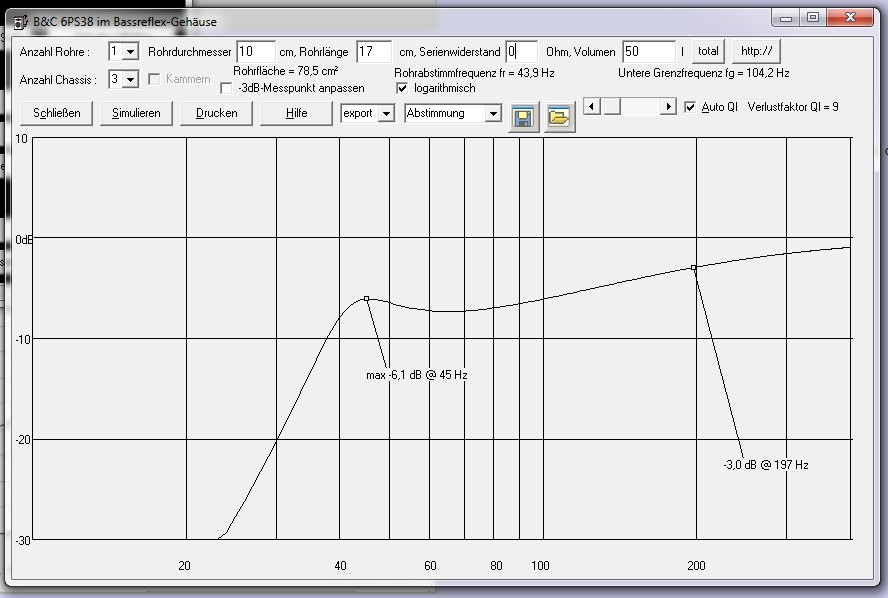
Do you see that bump at the end? That will get you, that sounds really bad and it becomes much worse with the power compression. And the excursion and the hole in the response/spl above it is no laughing matter either.
I've simulated a whole bunch of variants and none looked even remotely like the hornresp result, none are clean or usable for more than moderate party level. And none of the other PA drivers of that size will get you much better results, they aren't designed to play that deep, they are intended for tops/sat and small enclosures.
You'll get better results with hifi or even car audio drivers and while I'm not a fan of the latter, they will actually go deep enough and need a much smaller enclosure, 70x53,6x20 isn't exactly 'invisible'. I'm ofcourse not any kind of reference but that size and that low max-spl are exactly the opposite of the listed design targets. Just to be clear: I would not use hifi- or car-speakers either, I'd use actual PA subwoofers.
1 - you weren't using the T/S parameters I posted
2 - have you seen what happens when you put a subwoofer in a room?!
3 - You weren't simulating a slot-loaded bass reflex
4 - I disagree. You're welcome to post simulations of something better. Remember, I've got 450w of long-term thermal power handling (per cabinet) and already have the drivers sat in front of me. You'll have to annihilate the Hornresp simulation if you want me to think about building anything else.
Absolutely! Even a single 10" would perform better, it's roughly the same cone surface as 3 6" drivers.
3x 6"s have more cone area than a single 10" driver, and you've still got to get an Xmax of around 7mm. I have some 10" drivers that will do that. They're Faital Pro 10FH520 and I'm using them in the big PA system.
A pair of cheap 10"s would probably move the same amount of air as these three 6" drivers, but they won't give the LF extension I'm looking for in a cabinet this size. Isobaric might (might) work, but now you're using 4x 10"s to match 3x 6"s, and your box size has gone way up just to fit the drivers in.
To all - I'm under no illusions that bigger drivers in bigger boxes will provide more LF output. I have a big pile of subs based on Beyma 15P1200Nd drivers for when I want to rattle everything in a venue. What I was looking for here is something small that will provide a surprising amount of output and extension from a low-profile box.
For kicks, I ran a quick simulation of the JBL GTO1214s that I've got around, used for other projects. They give a response that slopes the opposite way - around 8dB drop from 42Hz to 100Hz. They have lower sensitivity and lower thermal power handling than the 3x 6"s. They do have a lot more volume displacement available, but their thermal power handling means they can't use it all without risking failure. Of course, a putting them in a larger box would increase efficiency, but then I might as well use the 15"s and do it properly.
Cheers, all.
Chris
Also with this enclosure design if you kill one driver the enclosure will be basically useless.
If I would do something like this, which I most certainly won`t, I would go for separate chambers for each driver.
Then if you kill one you could still use 2/3 of that box.
If I would do something like this, which I most certainly won`t, I would go for separate chambers for each driver.
Then if you kill one you could still use 2/3 of that box.
If you read my posts again, you'll see that I've measured the T/S parameters, and posted them.
For what it's worth, all drivers are "capable" of producing very low frequencies. It's just a matter of how loud.
Yes, I did not say anything different. If you'd care to read, I even said it numerous times.
No, it won't. I've pulled apart and measured commercial cabinets. To take an example, a KW181 will do 127dB at 70Hz, and 115dB at 40Hz (you can find that data online), and people actually like that box. A cheap 12" commercial sub won't get close to those numbers,
Ofcourse it won't do 40 Hz at 127dB because it's not tuned that deep, the -10dB point is at 37Hz. Why would you think it would deliver that level if it's not specified? Just because it's expensive? There are in fact 18", 15" and even 12" subs which actually deliver 120+dB at 40 Hz. Aside from that, you said yourself the planned sub maxes out at 65Hz - which other subs do not. And, I have to add, a lot of these subs can be EQ'd on the tuning frequency which extends the low end without exceeding the Xmax.
and besides, where's the fun in buying something pre-made?
I did not say you should buy some pre-made sub. But a comparison is in order to perfor a reality-check and that's what everyone should do. Yes, you can build a house out of matchsticks but that does not mean it useful or makes sense. You want to use the sub at venues, please honestly answer yourself the question if the spl will be enough.
and A further example would be that one of the venues I work regularly at uses a particular active speaker that I've done quite a lot of tests on - you can read all about that here:
Finding The Limits: Pursuing Useful Loudspeaker Specs, Including SPL - ProSoundWeb
That's about tops/sat. Ofcourse you can't use a top fullrange to the max spl. They aren't made for that, and everyone who assumes that, does not know how to handle, use and set up speakers. And they then said that themselves. Aside that, I was talking about a 12" sub and not about 129 dB, I was talking about 122 dB program/125 dB peak. I'd find it helpful if you'd actually read what you're complaining about.
I've never touched the limiters at that venue, either, although the bass compression may well have kicked in a couple of times.
How many PAX? What subs?
I ran a quick simulation of a LAB12 in a box similar to this [...]
*I* did not say anything about using a LAB12. And I did not say anything else other than plain and simple bassreflex. But while we're at it, the LAB15 does not need more enclosure volume.
Your SPL numbers are quite correct, for a single box. Add 6dB since there's going to be two of them, and then consider the fact that the sort of venues this will be used at have dimensions of the order of 10m.
This is not a PA system for a 500 capacity heavy metal venue. This is a system for full-range reinforcement in venues of up to 100, if they're sitting quietly (think of in an old church), or maybe up to 50 in a typical Sheffield pub.
1. You never said you'd build more than one.
2. You never said anything about the use or music or event type.
3. You said specifically "they might be used in any venue you can imagine."
1 - you weren't using the T/S parameters I posted
2 - have you seen what happens when you put a subwoofer in a room?!
3 - You weren't simulating a slot-loaded bass reflex
4 - I disagree. You're welcome to post simulations of something better. Remember, I've got 450w of long-term thermal power handling (per cabinet) and already have the drivers sat in front of me. You'll have to annihilate the Hornresp simulation if you want me to think about building anything else.
1 - You never posted the T/S parameters in the first place. No Qts, Qes, Qms, Vas or Fs! I took the parameters Brian Steele posted.
2 - You get a room gain and room modes, depending on the room, it's dimensions. You'll not only gain, you'll also have losses because of standing waves. That can worsen the bump at the lower end, especally at the power compression or you can have huge holes.
3 - For the lower cut off and spl it does not make any difference.
4 - You run out of Xmax at 168,75W. 450W will damage your drivers and will get you a huge ammount of distortion and mechanical noises. And you'd need a very steep lowcut to prevent undampened excursion below the port frequency anyway. On the bright side you won't run into power compression though. I don't have to annihilate anything and you can build whatever you want. I don't sell anything. I try to help you looking at your project realistically.
3x 6"s have more cone area than a single 10" driver, and you've still got to get an Xmax of around 7mm. I have some 10" drivers that will do that. They're Faital Pro 10FH520 and I'm using them in the big PA system.
No, you get 7mm Xvar. Did you read at B&C their Xvar already gives you 10% distortion? But the most important information escaped me too at first. They specify 6mm Xmax. The winding height is 12mm, the pole plate is 6mm. That's (12-6)/2 mathematically. That is not +/- 6mm, that's +/- 3mm!.
Attachments
1. The OP stated in post #1: "It started off with a pair of 6.5" PA speakers, and I thought it'd be good to have some low-profile subs to go with them - something to act as a base for a speaker pole to go between. It doesn't need to be anything huge, since the main speakers are small and fairly light."1. You never said you'd build more than one.
2. You never said anything about the use or music or event type.
3. You said specifically "they might be used in any venue you can imagine."
Pair=2. If you missed that, in post #8 Chris notes: "I only have 6 drivers in total, and can't get hold of any more."
2. The OP stated in post #1: "Ideally it'd go as low as possible while still retaining good output levels for smaller spaces, or venues where keeping the PA system near-invisible is important." In #3: "You can EQ it any way you like, but the conclusion is that it'll do 115dB at any frequency in it's operating band. Some frequencies, it will go louder than that."
One could use the little buggers for any type of music or event where the output would be appropriate.
3. The OP stated in post #1 "Output on two faces makes positioning more difficult when they might be used in any venue you can imagine."
The "smaller spaces, or venues where keeping the PA system near-invisible is important" I have worked in, or can imagine working in, don't require, or usually desire subs with more output than what Chris' little 3x6" can provide.
There are in fact 18", 15" and even 12" subs which actually deliver 120+dB at 40 Hz. Aside from that, you said yourself the planned sub maxes out at 65Hz - which other subs do not. And, I have to add, a lot of these subs can be EQ'd on the tuning frequency which extends the low end without exceeding the Xmax.
Data-Bass
You're welcome to try and find a single 12" cabinet that'll do the 125dB "peak" you suggest from 40Hz and upwards, or even the 122dB "program".
Let me try and make this really, really clear, since I don't think you're getting it: all ported subwoofers will run out of excursion above the port tuning frequency when enough voltage is applied.
In the case of the design in question, it's 30v at 65Hz. Every other ported cabinet on the planet has the very same issue. You can go through your own simulations and see for yourself.
Please please go through the simulations and make sure you understand this, because I feel like we're going around in circles and you're missing the point.
A LAB12 in a ported box tuned to 40Hz will do 120dB at 55Hz, and that's excursion-limited.
A Beyma 15P1200Nd in a 40Hz box will do 124.6dB at 59Hz at Xmax.
This box will do 118dB, excursion-limited, at 65Hz.
Note that these figures are only problems if the program material is sine waves at the worst-case frequency, and all the cabinets can therefore be expected to put out a little more SPL when wide-band program material is used.
To answer some of your other points:
- It was a pair of the 10" active speakers, no subwoofers.
- Your LAB15 simulation is at least 70L internal, once you've added the ports, and you haven't included the 2.83v sensitivity. 95dB@2.83v@40Hz, 100dB@2.83v@100Hz to beat.
- I trust B&C's assessment of the excursion limits of their drivers. You can feel the suspension start to lock up as you go past about 7mm of excursion. Talking about the motor geometry misses out a lot of important stuff. You might find that there's 2mm either side of the gap where the magnetic field is 90% as strong - the motor force doesn't switch off as soon as you move a tiny bit of coil out of the magnetic gap.
- I'm not complaining about anything. This is an interesting discussion, but I do think there's a hole in your understanding that I hope you rectify.
Chris
I'll make it very short:
1. You actually can make 122dB program, there are BP, BPH and even long excursion BR which can reach that. And I've already posted the LAB15, which does too in the same enclosure volume as the 3x 6".
2. With +/-3mm you will not get 115dB, not even close. Don't pray water if you're drinking wine yourself. Post the simulation of that excursion or, if you're generous, even take the +/-3.5mm. Wrong drivers for subs, period.
3. Suit yourself, build these subs. And then please post if you're satisfied. I have seen a lot of these projects starting but never seen one of these actually finish.
1. You actually can make 122dB program, there are BP, BPH and even long excursion BR which can reach that. And I've already posted the LAB15, which does too in the same enclosure volume as the 3x 6".
2. With +/-3mm you will not get 115dB, not even close. Don't pray water if you're drinking wine yourself. Post the simulation of that excursion or, if you're generous, even take the +/-3.5mm. Wrong drivers for subs, period.
3. Suit yourself, build these subs. And then please post if you're satisfied. I have seen a lot of these projects starting but never seen one of these actually finish.
- I trust B&C's assessment of the excursion limits of their drivers.
Well, I feel I have to answer that one still. Look at their datasheet (PDF). It leaves absolutely no doubt about 12mm winding height and 6mm pole plate thickness. They did not lie. They wrote Xmax, not +/- Xmax. They just didn't write what you wanted to read out of it.
ICG,Well, I feel I have to answer that one still. Look at their datasheet (PDF). It leaves absolutely no doubt about 12mm winding height and 6mm pole plate thickness. They did not lie. They wrote Xmax, not +/- Xmax. They just didn't write what you wanted to read out of it.
B&C told no lies about winding height, plate thickness or Xmax and Xvar.
If you want to believe the B&C 6ps38 Xmax is "wrong", you'll also have to throw out all the rest of their (and most everyone else's) woofer's Xmax ratings.
Deriving Xmax by subtracting the height of the voice coil winding from the height of the magnetic gap and dividing by 2 ignores magnetic and mechanical non-linearities and asymmetry, so has not been much in use since 1981, after which the measured approach started gaining traction. I can still remember when Mark Gander of JBL gave me a "top secret" paper about how to design ported cabinets using TS parameters back then...
B&C does provides Winding Depth and Magnetic Gap Depth on their spec sheets, but Xmax is not derived from those numbers, it is measured according to the AES2-1984 standard, corresponding to a maximum of 10% total harmonic distortion (THD) with a sinusoidal signal.
The “Xvar” value reported by B&C is measured as when the magnetic field seen by the voice coil, or the total suspension compliance, or both, drops to less than 50% of their small signal value.
Xvar can be more, less or equal to Xmax.
Art
Last edited:
- Status
- Not open for further replies.
- Home
- Loudspeakers
- Subwoofers
- Small PA Subwoofer - 3x 6.5" drivers.
